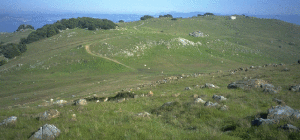
seven county view
We know nothing lasts forever. “The places that we have known belong not only to that little world of space on which we map them for our own convenience. None of them was ever more than a thin slice, held between the contiguous impressions that composed our life at that time; remembrance of a particular image is but regret for a particular moment; and houses, roads and avenues are as fugitive, alas! as the years.” Well stated, Marcel Proust!
I remember old days and olden times. I can describe every step going up to my childhood tree fort. We lived in a new cul-de-sac between Mill Valley and Tiburon, California. Before I walked my hills, the place was called Reed Station. My husband Fred’s great grandfather and grandfather lived on the exact spot more than one hundred years earlier. The Portuguese side of Fred’s family came from the Azore Islands after Gold Rush times, and they ran and owned dairies.
Miwok Indigenous People lived here for centuries before the Portuguese. The space has changed human beings.
I grew up outside, and my personal space remains wide open, strewn rocks and craggy grass hills. I feel like I’m sitting in my living room up there. I ‘map special memories for my own convenience.’ Proust also tried describing the physical sense of loss, mixed with understanding how much time has elapsed. “…remembrance of a particular image is but regret for a particular moment; and houses roads and avenues are as fugitive, alas! as the years.”
The French writer Gaston Bachelard wrote The Poetics of Space in France during the mid 1950’s, the same time I ran around outside in California. He was from the ‘Phenomenology’ school, using poetry as supporting evidence for theories of memory and identity. Bachelard poses that a person’s earliest interior spaces creates our physical understanding of how we shape identity in our adult years. “Interior spaces and components: the various rooms and the different types of furniture in it, are as important in shaping person’s identity for life.” “All our lives we come back to them in our daydreams.”
I use written language to understand my life. I also give credit to defining aspects of physical spaces, as mentioned by Proust and Bachelard. Each person grows up with different perceptions of what words mean, based on our memories of the outdoors and indoor spaces. For example, if I say ‘steep’, I think of climbing a dirt trail up to a vista overlooking seven counties in the Bay Area. My dear reader certainly has a completely different impression of the word ‘steep,’ based on their past experiences. Writers can help us see Thanksgiving tables differently, too, because our earliest physical environments were unique to us, but constantly change.
I hold physical memories in my heart around Thanksgiving holiday, when ghosts visit for a few hours. My definition of family has also changed in thirty years. Four of us now sit in the same house, where once there were more living relatives. Miraculously, small acres of the physical hills have been preserved, so particular physical landmarks haven’t changed, like a few trees, some boulder rocks, what remains of the familiar skyline. Some of the land remains above our house like it was when I grew up.
The beauty of the present moment, soon to be past, is most important here, too. Tomorrow, my grown sons will arrive from different parts of the West for the Thanksgiving weekend. I plan to prepare traditional foods they have come to expect, and we will enjoy our feast, and the experience will become archived, along with other Thanksgivings in our ‘thin slices’ of space and time.
Nothing else to do, but enjoy moments as they come. ‘Interior memories’ will endure for the rest of all our adult lives, with different intensity than when the children were young. Nobody relives, or ‘map’ exact experiences, even though that may be inconvenient, as Proust believed. We have to go with the rhythm of the day. Maybe we’ll take a walk into the hills, but the hills will be particular images for a particular moment.
Bless the writers to try and explain simultaneous experiences in written language. Hopefully we can convey sacredness through the visual space of words, if only for an instant.
Leave a Reply